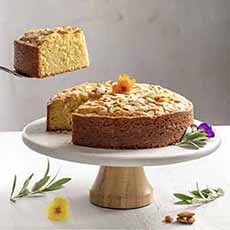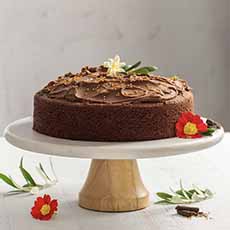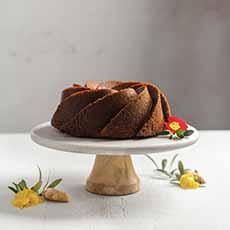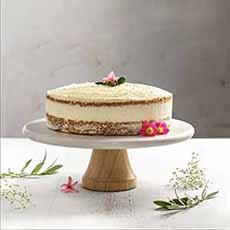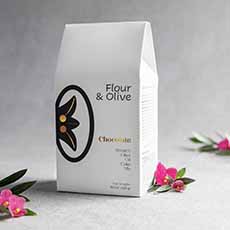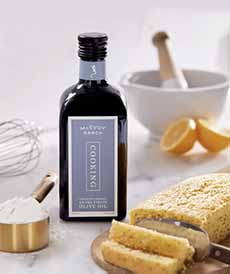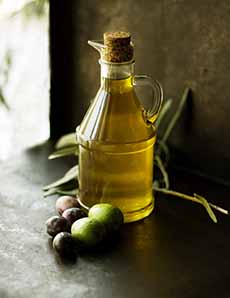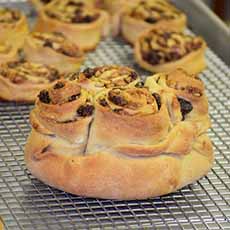Flour & Olive Gourmet Cake Mixes: Elegant & Easy
|
Olive oil cake is similar to any other cake, except for the fat. Olive oil is substituted for butter (or other fat) in the recipe. It’s important to use high-quality olive oil, as it will be a dominant flavor. We have long lamented a local bakery that closed after addicting us to its plain, simple, and oh-so-flavorful olive oil cakes. So when we came across Flour & Olive, an artisan company specializing in olive oil cake mixes, we were so happy we gave everyone a box for Christmas. —Karen Hochman The four olive oil cake mixes—Almond, Chocolate, Ginger, and Vanilla—are crafted from a custom blend of unbleached and whole wheat flours. The mixes are designed to be paired with extra virgin olive oil, a simple baking method and our interactive International Collection of over 70 recipes that transport your senses all over the world and include vegan and dairy free options. There are some 70 recipes. All can be served plain or iced. Just four examples for each cake mix: > Head to FlourAndOlive.com. > The different types of cake: a photo glossary. > The different types of olives and olive oil: a photo glossary. > Cakes, gâteaux, tarts, and tortes: the difference. Olive oil has some distinct advantages over butter: The history of olive oil cake is rooted in the Mediterranean, where olive trees have been cultivated for thousands of years. The wild olive tree (Olea oleaster), originated in an area of the eastern Mediterranean region that includes parts of modern-day Lebanon, Palestine/Israel, and Syria. The tree began to be cultivated around 6000-5500 B.C.E. in the Levant‡‡. The domesticated olive tree (Olea europaea) then spread westward across the Mediterranean, reaching Greece, Rome, and elsewhere through trade and cultural exchange. Olive oil was used for beauty, household, medicine, and religious rituals, as well as for cooking. The ancient Egyptians were the world’s first great bakers. Combine that with the fact that olives were cultivated in Egypt possibly as far back as the Early Dynastic Period (c. 3150-2686 B.C.E.). Hard archaeological evidence, such as olive pits and wood remains, dates back to at least the New Kingdom (c. 1550-1070 B.C.E.), if not earlier (source: Claude.ai 2025-01-04). We can assume that Egyptians used the oil for baking. But the first major bakers of olive oil cake appear to be the Greeks. By around 3000 B.C.E., olive oil had become so integral to Greek civilization that the olive branch turned into a symbol of peace. Cooks began to incorporating the oil into their cakes*, among other foods, giving birth to the olive oil cake. In addition to spreading olive cultivation to their colonies and trading networks across the Mediterranean, the Greeks made significant improvements in cultivation techniques and created new cultivars‡‡‡ through selective breeding. In the Christian era, in many Mediterranean countries including Greece and Italy, olive oil cake became a customary treat during the holiday season [source]. In Italy’s Calabria region, for example, olive oil cakes called Pitta ‘mpigliata† or Pitta China, are traditional Christmas desserts: spiral-shaped pastries filled with nuts, dried fruit, and spices. Beyond the simple olive oil cake, many variations have evolved.
|
|
|
|
________________ *Olive oil cakes are moister due to the oil’s superior ability to retain moisture. Butter contains water that evaporates during baking. **Olive oil is pareve, a term in Jewish dietary laws (kashrut/kosher) that refers to foods/ingredients that can be eaten with both meat and dairy products. Per Jewish law, meat products and dairy products cannot be consumed at the same meal (here’s why). In the case of baked goods made with oil instead of butter (a dairy product), the cake could be eaten at either a meat meal or a dairy meal. Otherwise, those who observe kashrut must wait six hours between consuming meat and dairy. †Pitta ‘mpigliata meaning: In the Calabrese dialect, the word pitta is a variation on pizza, which is itself related to the Arab word pita, meaning pie or cake. Impigliata means entangled, as are the fruits and nuts entangled in the pastry. Pitta China is a stuffed pastry. ‡Making butter: In addition to 16 ounces of butter from a quart of cream, you’ll also get two cups of buttermilk as a by-product. While the price of both commodities varies, as of this writing a pound of butter (four sticks) at Trader Joe’s was $3.99, or 25¢/ounce. A 33.8-ounce bottle of Italian olive oil was $10.99, or 33¢/ounce [source]. However, for baking an olive oil cake, you should use EVOO, not cooking oil. Trader Joe’s Premium Extra Virgin Olive Oil is $12.99, or 41¢/ounce. Factoid: It takes one quart of cream (32 ounces) to make one pound of butter (16 ounces). ‡‡The Levant is a large area in the Eastern Mediterranean region that comprises modern-day Israel, Jordan, Lebanon, Palestine, Syria, and a small part of southern Turkey. ‡‡‡A cultivar is a type of cultivated plant that growers have selected for desired traits. It retains those traits when propagated. Methods used to propagate cultivars include root and stem cuttings, grafting, and carefully controlled seed production, among others. CHECK OUT WHAT’S HAPPENING ON OUR HOME PAGE, THENIBBLE.COM. |
||
